

Android消息机制2-Handler(Native层)
source link: http://yuanfentiank789.github.io/2015/12/27/handler-message-native/
Go to the source link to view the article. You can view the picture content, updated content and better typesetting reading experience. If the link is broken, please click the button below to view the snapshot at that time.

本文基于Android 6.0的源代码,来分析native层的消息处理机制
相关源码
framework/base/core/java/andorid/os/MessageQueue.java
framework/base/core/jni/android_os_MessageQueue.h
framework/base/core/jni/android_os_MessageQueue.cpp
system/core/include/utils/Looper.h
system/core/libutils/Looper.cpp
system/core/libutils/RefBase.cpp
framework/native/include/android/looper.h
framework/base/native/android/looper.cpp
在文章Android消息机制1-Handler(Java层)中讲解了Java层的消息处理机制,其中MessageQueue类里面涉及到多个native方法,除了MessageQueue的native方法,native层本身也有一套完整的消息机制,用于处理native的消息。在整个消息机制中,而MessageQueue是连接Java层和Native层的纽带,换言之,Java层可以向MessageQueue消息队列中添加消息,Native层也可以向MessageQueue消息队列中添加消息。
Native层的关系图

二、MessageQueue
在MessageQueue中的native方法如下:
private native static long nativeInit();
private native static void nativeDestroy(long ptr);
private native void nativePollOnce(long ptr, int timeoutMillis);
private native static void nativeWake(long ptr);
private native static boolean nativeIsPolling(long ptr);
private native static void nativeSetFileDescriptorEvents(long ptr, int fd, int events);
2.1 nativeInit()
初始化过程的调用链如下:
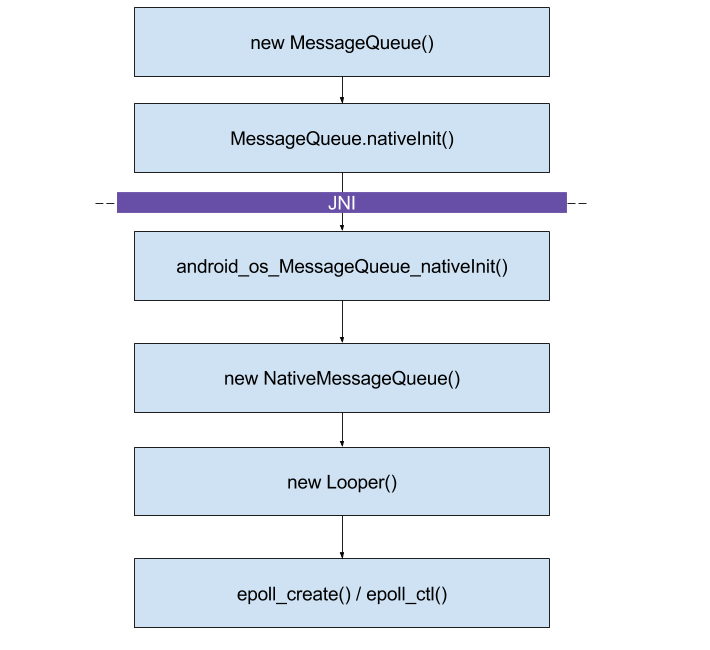
下面来进一步来看看调用链的过程:
【1】 new MessageQueue()
==> MessageQueue.java
MessageQueue(boolean quitAllowed) {
mQuitAllowed = quitAllowed;
mPtr = nativeInit(); //mPtr记录native消息队列的信息 【2】
}
【2】android_os_MessageQueue_nativeInit()
==> android_os_MessageQueue.cpp
static jlong android_os_MessageQueue_nativeInit(JNIEnv* env, jclass clazz) {
NativeMessageQueue* nativeMessageQueue = new NativeMessageQueue(); //初始化native消息队列 【3】
if (!nativeMessageQueue) {
jniThrowRuntimeException(env, "Unable to allocate native queue");
return 0;
}
nativeMessageQueue->incStrong(env);
return reinterpret_cast<jlong>(nativeMessageQueue);
}
【3】new NativeMessageQueue()
==> android_os_MessageQueue.cpp
NativeMessageQueue::NativeMessageQueue() : mPollEnv(NULL), mPollObj(NULL), mExceptionObj(NULL) {
mLooper = Looper::getForThread(); //获取TLS中的Looper对象
if (mLooper == NULL) {
mLooper = new Looper(false); //创建native层的Looper 【4】
Looper::setForThread(mLooper); //保存native层的Looper到TLS中
}
}
- Looper::getForThread(),功能类比于Java层的Looper.myLooper();
- Looper::setForThread(mLooper),功能类比于Java层的ThreadLocal.set();
MessageQueue是在Java层与Native层有着紧密的联系,但是此次Native层的Looper与Java层的Looper没有任何的关系,可以发现native基本等价于用C++重写了Java的Looper逻辑,故可以发现很多功能类似的地方。
【4】new Looper()
==> Looper.cpp
Looper::Looper(bool allowNonCallbacks) :
mAllowNonCallbacks(allowNonCallbacks), mSendingMessage(false),
mPolling(false), mEpollFd(-1), mEpollRebuildRequired(false),
mNextRequestSeq(0), mResponseIndex(0), mNextMessageUptime(LLONG_MAX) {
mWakeEventFd = eventfd(0, EFD_NONBLOCK); //构造唤醒事件的fd
AutoMutex _l(mLock);
rebuildEpollLocked(); //重建Epoll事件【5】
}
【5】epoll_create/epoll_ctl
==> Looper.cpp
void Looper::rebuildEpollLocked() {
if (mEpollFd >= 0) {
close(mEpollFd); //关闭旧的epoll实例
}
mEpollFd = epoll_create(EPOLL_SIZE_HINT); //创建新的epoll实例,并注册wake管道
struct epoll_event eventItem;
memset(& eventItem, 0, sizeof(epoll_event)); //把未使用的数据区域进行置0操作
eventItem.events = EPOLLIN; //可读事件
eventItem.data.fd = mWakeEventFd;
//将唤醒事件(mWakeEventFd)添加到epoll实例(mEpollFd)
int result = epoll_ctl(mEpollFd, EPOLL_CTL_ADD, mWakeEventFd, & eventItem);
for (size_t i = 0; i < mRequests.size(); i++) {
const Request& request = mRequests.valueAt(i);
struct epoll_event eventItem;
request.initEventItem(&eventItem);
//将request队列的事件,分别添加到epoll实例
int epollResult = epoll_ctl(mEpollFd, EPOLL_CTL_ADD, request.fd, & eventItem);
if (epollResult < 0) {
ALOGE("Error adding epoll events for fd %d while rebuilding epoll set, errno=%d", request.fd, errno);
}
}
}
关于epoll的原理以及为什么选择epoll的方式,可查看文章select/poll/epoll对比分析。
另外,需要注意Request队列,也添加到epoll的监控范围内。
2.2 nativeDestroy()
清理回收的调用链如下:
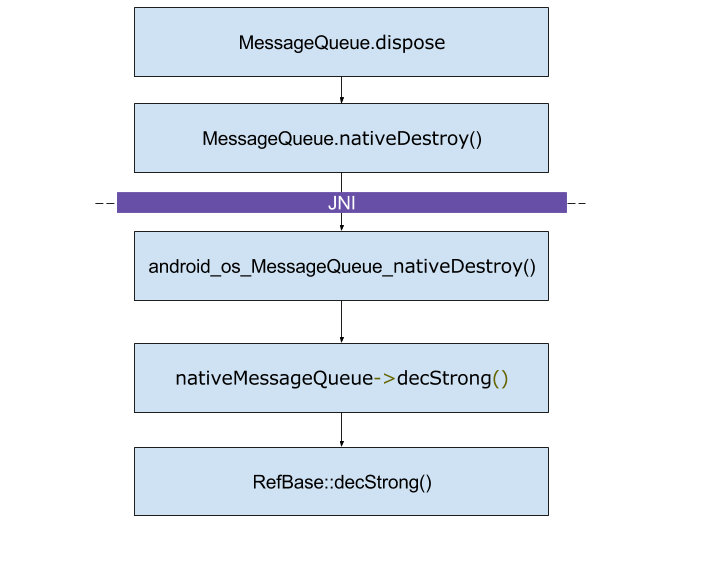
下面来进一步来看看调用链的过程:
【1】MessageQueue.dispose()
==> MessageQueue.java
private void dispose() {
if (mPtr != 0) {
nativeDestroy(mPtr); 【2】
mPtr = 0;
}
}
【2】android_os_MessageQueue_nativeDestroy()
==> android_os_MessageQueue.cpp
static void android_os_MessageQueue_nativeDestroy(JNIEnv* env, jclass clazz, jlong ptr) {
NativeMessageQueue* nativeMessageQueue = reinterpret_cast<NativeMessageQueue*>(ptr);
nativeMessageQueue->decStrong(env); 【3】
}
nativeMessageQueue继承自RefBase类,所以decStrong最终调用的是RefBase.decStrong().
【3】RefBase::decStrong()
==> RefBase.cpp
void RefBase::decStrong(const void* id) const
{
weakref_impl* const refs = mRefs;
refs->removeStrongRef(id); //移除强引用
const int32_t c = android_atomic_dec(&refs->mStrong);
if (c == 1) {
refs->mBase->onLastStrongRef(id);
if ((refs->mFlags&OBJECT_LIFETIME_MASK) == OBJECT_LIFETIME_STRONG) {
delete this;
}
}
refs->decWeak(id); // 移除弱引用
}
2.3 nativePollOnce()
nativePollOnce用于提取消息队列中的消息,提取消息的调用链,如下:
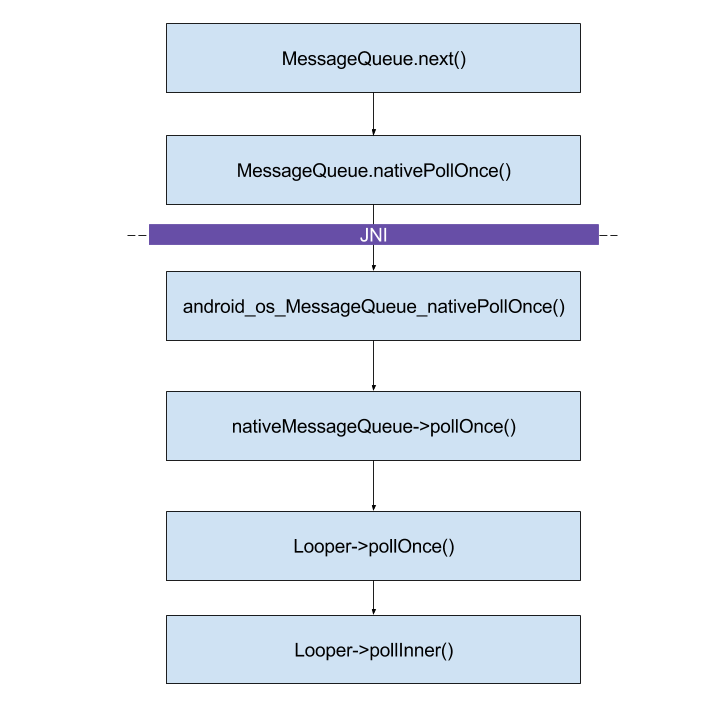
下面来进一步来看看调用链的过程:
【1】MessageQueue.next()
==> MessageQueue.java
Message next() {
final long ptr = mPtr;
if (ptr == 0) {
return null;
}
for (;;) {
...
nativePollOnce(ptr, nextPollTimeoutMillis); //阻塞操作 【2】
...
}
【2】android_os_MessageQueue_nativePollOnce()
==> android_os_MessageQueue.cpp
static void android_os_MessageQueue_nativePollOnce(JNIEnv* env, jobject obj, jlong ptr, jint timeoutMillis) {
//将Java层传递下来的mPtr转换为nativeMessageQueue
NativeMessageQueue* nativeMessageQueue = reinterpret_cast<NativeMessageQueue*>(ptr);
nativeMessageQueue->pollOnce(env, obj, timeoutMillis); 【3】
}
【3】NativeMessageQueue::pollOnce()
==> android_os_MessageQueue.cpp
void NativeMessageQueue::pollOnce(JNIEnv* env, jobject pollObj, int timeoutMillis) {
mPollEnv = env;
mPollObj = pollObj;
mLooper->pollOnce(timeoutMillis); 【4】
mPollObj = NULL;
mPollEnv = NULL;
if (mExceptionObj) {
env->Throw(mExceptionObj);
env->DeleteLocalRef(mExceptionObj);
mExceptionObj = NULL;
}
}
【4】Looper::pollOnce()
==> Looper.h
inline int pollOnce(int timeoutMillis) {
return pollOnce(timeoutMillis, NULL, NULL, NULL); 【5】
}
【5】 Looper::pollOnce()
==> Looper.cpp
int Looper::pollOnce(int timeoutMillis, int* outFd, int* outEvents, void** outData) {
int result = 0;
for (;;) {
// 先处理没有Callback方法的 Response事件
while (mResponseIndex < mResponses.size()) {
const Response& response = mResponses.itemAt(mResponseIndex++);
int ident = response.request.ident;
if (ident >= 0) { //ident大于0,则表示没有callback, 因为POLL_CALLBACK = -2,
int fd = response.request.fd;
int events = response.events;
void* data = response.request.data;
if (outFd != NULL) *outFd = fd;
if (outEvents != NULL) *outEvents = events;
if (outData != NULL) *outData = data;
return ident;
}
}
if (result != 0) {
if (outFd != NULL) *outFd = 0;
if (outEvents != NULL) *outEvents = 0;
if (outData != NULL) *outData = NULL;
return result;
}
// 再处理内部轮询
result = pollInner(timeoutMillis); 【6】
}
}
参数说明:
- timeoutMillis:超时时长
- outFd:发生事件的文件描述符
- outEvents:当前outFd上发生的事件,包含以下4类事件
- EVENT_INPUT 可读
- EVENT_OUTPUT 可写
- EVENT_ERROR 错误
- EVENT_HANGUP 中断
- outData:上下文数据
【6】Looper::pollInner()
==> Looper.cpp
int Looper::pollInner(int timeoutMillis) {
...
int result = POLL_WAKE;
mResponses.clear();
mResponseIndex = 0;
mPolling = true; //即将处于idle状态
struct epoll_event eventItems[EPOLL_MAX_EVENTS]; //fd最大个数为16
//等待事件发生或者超时,在nativeWake()方法,向管道写端写入字符,则该方法会返回;
int eventCount = epoll_wait(mEpollFd, eventItems, EPOLL_MAX_EVENTS, timeoutMillis);
mPolling = false; //不再处于idle状态
mLock.lock(); //请求锁
if (mEpollRebuildRequired) {
mEpollRebuildRequired = false;
rebuildEpollLocked(); // epoll重建,直接跳转Done;
goto Done;
}
if (eventCount < 0) {
if (errno == EINTR) {
goto Done;
}
result = POLL_ERROR; // epoll事件个数小于0,发生错误,直接跳转Done;
goto Done;
}
if (eventCount == 0) { //epoll事件个数等于0,发生超时,直接跳转Done;
result = POLL_TIMEOUT;
goto Done;
}
//循环遍历,处理所有的事件
for (int i = 0; i < eventCount; i++) {
int fd = eventItems[i].data.fd;
uint32_t epollEvents = eventItems[i].events;
if (fd == mWakeEventFd) {
if (epollEvents & EPOLLIN) {
awoken(); //已经唤醒了,则读取并清空管道数据【7】
}
} else {
ssize_t requestIndex = mRequests.indexOfKey(fd);
if (requestIndex >= 0) {
int events = 0;
if (epollEvents & EPOLLIN) events |= EVENT_INPUT;
if (epollEvents & EPOLLOUT) events |= EVENT_OUTPUT;
if (epollEvents & EPOLLERR) events |= EVENT_ERROR;
if (epollEvents & EPOLLHUP) events |= EVENT_HANGUP;
//处理request,生成对应的reponse对象,push到响应数组
pushResponse(events, mRequests.valueAt(requestIndex));
}
}
}
Done: ;
//再处理Native的Message,调用相应回调方法
mNextMessageUptime = LLONG_MAX;
while (mMessageEnvelopes.size() != 0) {
nsecs_t now = systemTime(SYSTEM_TIME_MONOTONIC);
const MessageEnvelope& messageEnvelope = mMessageEnvelopes.itemAt(0);
if (messageEnvelope.uptime <= now) {
{
sp<MessageHandler> handler = messageEnvelope.handler;
Message message = messageEnvelope.message;
mMessageEnvelopes.removeAt(0);
mSendingMessage = true;
mLock.unlock(); //释放锁
handler->handleMessage(message); // 处理消息事件
}
mLock.lock(); //请求锁
mSendingMessage = false;
result = POLL_CALLBACK; // 发生回调
} else {
mNextMessageUptime = messageEnvelope.uptime;
break;
}
}
mLock.unlock(); //释放锁
//处理带有Callback()方法的Response事件,执行Reponse相应的回调方法
for (size_t i = 0; i < mResponses.size(); i++) {
Response& response = mResponses.editItemAt(i);
if (response.request.ident == POLL_CALLBACK) {
int fd = response.request.fd;
int events = response.events;
void* data = response.request.data;
// 处理请求的回调方法
int callbackResult = response.request.callback->handleEvent(fd, events, data);
if (callbackResult == 0) {
removeFd(fd, response.request.seq); //移除fd
}
response.request.callback.clear(); //清除reponse引用的回调方法
result = POLL_CALLBACK; // 发生回调
}
}
return result;
}
pollOnce返回值说明:
- POLL_WAKE: 表示由wake()触发,即pipe写端的write事件触发;
- POLL_CALLBACK: 表示某个被监听fd被触发。
- POLL_TIMEOUT: 表示等待超时;
- POLL_ERROR:表示等待期间发生错误;
【7】Looper::awoken()
void Looper::awoken() {
uint64_t counter;
//不断读取管道数据,目的就是为了清空管道内容
TEMP_FAILURE_RETRY(read(mWakeEventFd, &counter, sizeof(uint64_t)));
}
poll小结
pollInner()方法的处理流程:
- 先调用epoll_wait(),这是阻塞方法,用于等待事件发生或者超时;
- 对于epoll_wait()返回,当且仅当以下3种情况出现:
- POLL_ERROR,发生错误,直接跳转到Done;
- POLL_TIMEOUT,发生超时,直接跳转到Done;
- 检测到管道有事件发生,则再根据情况做相应处理:
- 如果是管道读端产生事件,则直接读取管道的数据;
- 如果是其他事件,则处理request,生成对应的reponse对象,push到reponse数组;
- 进入Done标记位的代码段:
- 先处理Native的Message,调用Native 的Handler来处理该Message;
- 再处理Response数组,POLL_CALLBACK类型的事件;
从上面的流程,可以发现对于Request先收集,一并放入reponse数组,而不是马上执行。真正在Done开始执行的时候,是先处理native Message,再处理Request,说明native Message的优先级高于Request请求的优先级。
另外pollOnce()方法中,先处理Response数组中不带Callback的事件,再调用了pollInner()方法。
2.4 nativeWake()
nativeWake用于唤醒功能,在添加消息到消息队列enqueueMessage(), 或者把消息从消息队列中全部移除quit(),再有需要时都会调用
nativeWake方法。包含唤醒过程的添加消息的调用链,如下:
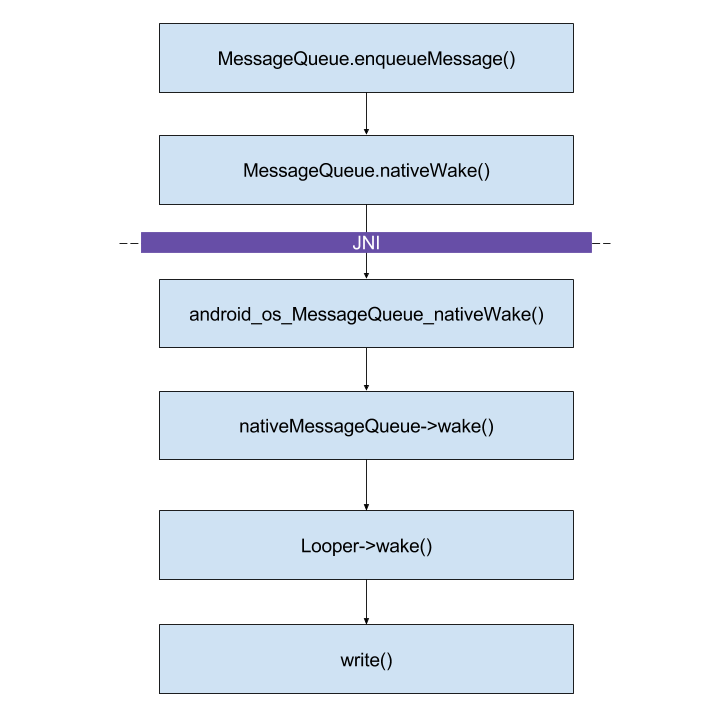
下面来进一步来看看调用链的过程:
【1】MessageQueue.enqueueMessage()
==> MessageQueue.java
boolean enqueueMessage(Message msg, long when) {
... //将Message按时间顺序插入MessageQueue
if (needWake) {
nativeWake(mPtr); 【2】
}
}
往消息队列添加Message时,需要根据mBlocked情况来决定是否需要调用nativeWake。
【2】android_os_MessageQueue_nativeWake()
==> android_os_MessageQueue.cpp
static void android_os_MessageQueue_nativeWake(JNIEnv* env, jclass clazz, jlong ptr) {
NativeMessageQueue* nativeMessageQueue = reinterpret_cast<NativeMessageQueue*>(ptr);
nativeMessageQueue->wake(); 【3】
}
【3】NativeMessageQueue::wake()
==> android_os_MessageQueue.cpp
void NativeMessageQueue::wake() {
mLooper->wake(); 【4】
}
【4】Looper::wake()
==> Looper.cpp
void Looper::wake() {
uint64_t inc = 1;
// 向管道mWakeEventFd写入字符1
ssize_t nWrite = TEMP_FAILURE_RETRY(write(mWakeEventFd, &inc, sizeof(uint64_t)));
if (nWrite != sizeof(uint64_t)) {
if (errno != EAGAIN) {
ALOGW("Could not write wake signal, errno=%d", errno);
}
}
}
其中TEMP_FAILURE_RETRY 是一个宏定义, 当执行write失败后,会不断重复执行,直到执行成功为止。
2.5 sendMessage
在Android消息机制1-Handler(Java层)文中,讲述了Java层如何向MessageQueue类中添加消息,那么接下来讲讲Native层如何向MessageQueue发送消息。
【1】sendMessage
void Looper::sendMessage(const sp<MessageHandler>& handler, const Message& message) {
nsecs_t now = systemTime(SYSTEM_TIME_MONOTONIC);
sendMessageAtTime(now, handler, message);
}
【2】sendMessageDelayed
void Looper::sendMessageDelayed(nsecs_t uptimeDelay, const sp<MessageHandler>& handler,
const Message& message) {
nsecs_t now = systemTime(SYSTEM_TIME_MONOTONIC);
sendMessageAtTime(now + uptimeDelay, handler, message);
}
sendMessage(),sendMessageDelayed() 都是调用sendMessageAtTime()来完成消息插入。
【3】sendMessageAtTime
void Looper::sendMessageAtTime(nsecs_t uptime, const sp<MessageHandler>& handler,
const Message& message) {
size_t i = 0;
{ //请求锁
AutoMutex _l(mLock);
size_t messageCount = mMessageEnvelopes.size();
//找到message应该插入的位置i
while (i < messageCount && uptime >= mMessageEnvelopes.itemAt(i).uptime) {
i += 1;
}
MessageEnvelope messageEnvelope(uptime, handler, message);
mMessageEnvelopes.insertAt(messageEnvelope, i, 1);
//如果当前正在发送消息,那么不再调用wake(),直接返回。
if (mSendingMessage) {
return;
}
} //释放锁
//当把消息加入到消息队列的头部时,需要唤醒poll循环。
if (i == 0) {
wake();
}
}
2.6 小结
本节介绍MessageQueue的native()方法,经过层层调用:
- nativeInit()方法,最终实现由epoll机制中的epoll_create()/epoll_ctl()完成;
- nativeDestroy()方法,最终实现由RefBase::decStrong()完成;
- nativePollOnce()方法,最终实现由Looper::pollOnce()完成;
- nativeWake()方法,最终实现由Looper::wake()调用write方法,向管道写入字符;
- nativeIsPolling(),nativeSetFileDescriptorEvents()这两个方法类似,此处就不一一列举。
三、Native结构体和类
Looper.h/ Looper.cpp文件中,定义了Message结构体,消息处理类,回调类,Looper类。
3.1 Message结构体
struct Message {
Message() : what(0) { }
Message(int what) : what(what) { }
int what; // 消息类型
};
3.2 消息处理类
MessageHandler类
class MessageHandler : public virtual RefBase {
protected:
virtual ~MessageHandler() { }
public:
virtual void handleMessage(const Message& message) = 0;
};
WeakMessageHandler类,继承于MessageHandler类
class WeakMessageHandler : public MessageHandler {
protected:
virtual ~WeakMessageHandler();
public:
WeakMessageHandler(const wp<MessageHandler>& handler);
virtual void handleMessage(const Message& message);
private:
wp<MessageHandler> mHandler;
};
void WeakMessageHandler::handleMessage(const Message& message) {
sp<MessageHandler> handler = mHandler.promote();
if (handler != NULL) {
handler->handleMessage(message); //调用MessageHandler类的处理方法()
}
}
3.3 回调类
LooperCallback类
class LooperCallback : public virtual RefBase {
protected:
virtual ~LooperCallback() { }
public:
//用于处理指定的文件描述符的poll事件
virtual int handleEvent(int fd, int events, void* data) = 0;
};
SimpleLooperCallback类, 继承于LooperCallback类
class SimpleLooperCallback : public LooperCallback {
protected:
virtual ~SimpleLooperCallback();
public:
SimpleLooperCallback(Looper_callbackFunc callback);
virtual int handleEvent(int fd, int events, void* data);
private:
Looper_callbackFunc mCallback;
};
int SimpleLooperCallback::handleEvent(int fd, int events, void* data) {
return mCallback(fd, events, data); //调用回调方法
}
3.4 Looper类
static const int EPOLL_SIZE_HINT = 8; //每个epoll实例默认的文件描述符个数
static const int EPOLL_MAX_EVENTS = 16; //轮询事件的文件描述符的个数上限
其中Looper类的内部定义了Request,Response,MessageEnvelope这3个结构体,关系图如下:
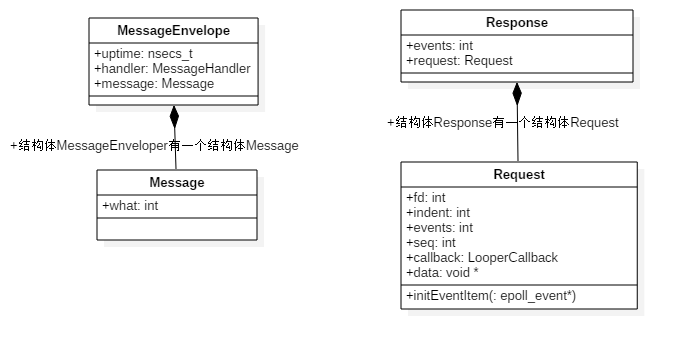
代码如下:
struct Request { //请求结构体
int fd;
int ident;
int events;
int seq;
sp<LooperCallback> callback;
void* data;
void initEventItem(struct epoll_event* eventItem) const;
};
struct Response { //响应结构体
int events;
Request request;
};
struct MessageEnvelope { //信封结构体
MessageEnvelope() : uptime(0) { }
MessageEnvelope(nsecs_t uptime, const sp<MessageHandler> handler,
const Message& message) : uptime(uptime), handler(handler), message(message) {
}
nsecs_t uptime;
sp<MessageHandler> handler;
Message message;
};
MessageEnvelope正如其名字,信封。MessageEnvelope里面记录着收信人(handler),发信时间(uptime),信件内容(message)
3.5 ALooper类
ALooper类定义在通过looper.cpp/looper.h(注意此文件是小写字母开头,与Looper.cpp不同,具体源码路径,可通过查看文章最开头的 相关源码)
static inline Looper* ALooper_to_Looper(ALooper* alooper) {
return reinterpret_cast<Looper*>(alooper);
}
static inline ALooper* Looper_to_ALooper(Looper* looper) {
return reinterpret_cast<ALooper*>(looper);
}
ALooper类 与前面介绍的Looper类,更多的操作是通过ALooper_to_Looper(), Looper_to_ALooper()这两个方法转换完成的,也就是说ALooper类中定义的所有方法,都是通过转换为Looper类,再执行Looper中的方法。
MessageQueue通过mPtr变量保存NativeMessageQueue对象,从而使得MessageQueue成为Java层和Native层的枢纽,既能处理上层消息,也能处理native层消息;下面列举Java层与Native层的对应图
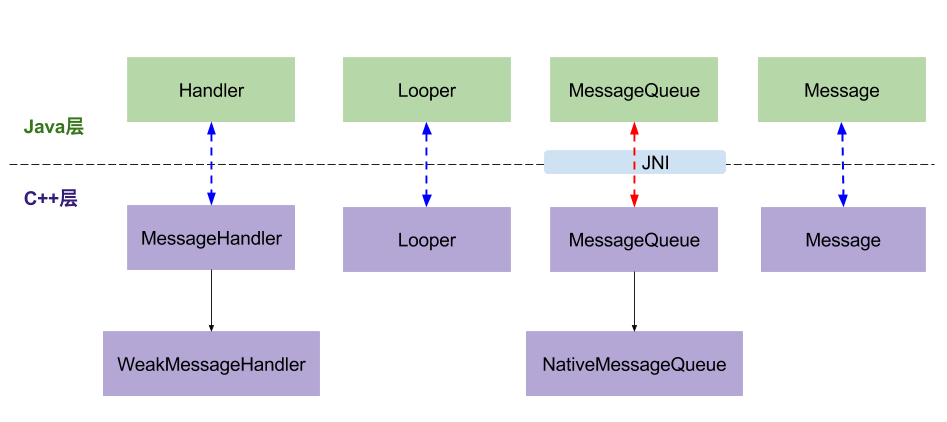
- 红色虚线关系:Java层和Native层的MessageQueue通过JNI建立关联,彼此之间能相互调用,搞明白这个互调关系,也就搞明白了Java如何调用C++代码,C++代码又是如何调用Java代码。
- 蓝色虚线关系:Handler/Looper/Message这三大类Java层与Native层并没有任何的真正关联,只是分别在Java层和Native层的handler消息模型中具有相似的功能。都是彼此独立的,各自实现相应的逻辑。
- WeakMessageHandler继承于MessageHandler类,NativeMessageQueue继承于MessageQueue类
另外,消息处理流程是先处理Native Message,再处理Native Request,最后处理Java Message。理解了该流程,也就明白有时上层消息很少,但响应时间却较长的真正原因。
Recommend
About Joyk
Aggregate valuable and interesting links.
Joyk means Joy of geeK